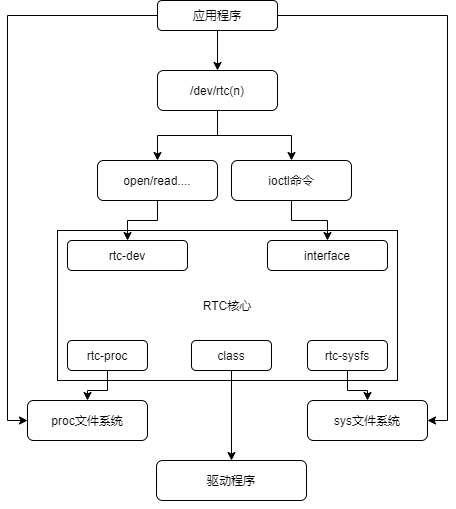

Linux驱动分析之RTC框架
电子说
1.4w人已加入
描述
前言

当Linux内核启动时,它会从RTC中读取时间与日期,作为基准值。然后通过软件来维护系统时间和日期。Linux系统中提供了RTC核心层,对于驱动开发者而言,操作起来就变得很简单了。我们来看看整体框架。
驱动框架

下面是整体框架图 :

与RTC核心有关的文件有:
| 文件 | 描述 |
|---|---|
| /drivers/rtc/class.c | 这个文件向linux设备模型核心注册了一个类RTC,然后向驱动程序提供了注册/注销接口 |
| /drivers/rtc/rtc-dev.c | 这个文件定义了基本的设备文件操作函数,如:open,read等 |
| /drivers/rtc/interface.c | 这个文件主要提供了用户程序与RTC驱动的接口函数,用户程序一般通过ioctl与RTC驱动交互,这里定义了每个ioctl命令需要调用的函数 |
| /drivers/rtc/rtc-sysfs.c | 与sysfs有关 |
| /drivers/rtc/rtc-proc.c | 与proc文件系统有关 |
| /include/linux/rtc.h | 定义了与RTC有关的数据结构 |
重要结构体

- rtc_device
//RTC设备
struct rtc_device {
struct device dev;
struct module *owner;
int id;
const struct rtc_class_ops *ops; //rtc操作函数
struct mutex ops_lock;
struct cdev char_dev;
unsigned long flags;
unsigned long irq_data;
spinlock_t irq_lock;
wait_queue_head_t irq_queue;
struct fasync_struct *async_queue;
int irq_freq;
int max_user_freq;
struct timerqueue_head timerqueue;
struct rtc_timer aie_timer;
struct rtc_timer uie_rtctimer;
struct hrtimer pie_timer; /* sub second exp, so needs hrtimer */
int pie_enabled;
struct work_struct irqwork;
/* Some hardware can't support UIE mode */
int uie_unsupported;
long set_offset_nsec;
bool registered;
struct nvmem_device *nvmem;
/* Old ABI support */
bool nvram_old_abi;
struct bin_attribute *nvram;
time64_t range_min;
timeu64_t range_max;
time64_t start_secs;
time64_t offset_secs;
bool set_start_time;
#ifdef CONFIG_RTC_INTF_DEV_UIE_EMUL
struct work_struct uie_task;
struct timer_list uie_timer;
/* Those fields are protected by rtc->irq_lock */
unsigned int oldsecs;
unsigned int uie_irq_active:1;
unsigned int stop_uie_polling:1;
unsigned int uie_task_active:1;
unsigned int uie_timer_active:1;
#endif
};
上面的结构体表示一个RTC设备,比较简单,主要就是中断信息,字符设备对象,操作函数等。
- rtc_class_ops
//RTC操作函数
struct rtc_class_ops {
int (*ioctl)(struct device *, unsigned int, unsigned long);
int (*read_time)(struct device *, struct rtc_time *);
int (*set_time)(struct device *, struct rtc_time *);
int (*read_alarm)(struct device *, struct rtc_wkalrm *);
int (*set_alarm)(struct device *, struct rtc_wkalrm *);
int (*proc)(struct device *, struct seq_file *);
int (*set_mmss64)(struct device *, time64_t secs);
int (*set_mmss)(struct device *, unsigned long secs);
int (*read_callback)(struct device *, int data);
int (*alarm_irq_enable)(struct device *, unsigned int enabled);
int (*read_offset)(struct device *, long *offset);
int (*set_offset)(struct device *, long offset);
};
就是一些设置时间和读取时间,以及闹钟等接口函数。
- rtc_time
//时间结构体
struct rtc_time {
int tm_sec;
int tm_min;
int tm_hour;
int tm_mday;
int tm_mon;
int tm_year;
int tm_wday;
int tm_yday;
int tm_isdst;
};
API函数

// 注册RTC class
static struct rtc_device *rtc_device_register(const char *name,
struct device *dev,
const struct rtc_class_ops *ops,
struct module *owner)
struct rtc_device *devm_rtc_device_register(struct device *dev,
const char *name,
const struct rtc_class_ops *ops,
struct module *owner)
//注销RTC
static void rtc_device_unregister(struct rtc_device *rtc)
void devm_rtc_device_unregister(struct device *dev, struct rtc_device *rtc)
总结

RTC也是字符设备驱动,只是进行了封装,封装完之后我们调用起来其实就很简单了。只要实现好接口函数,填充好结构体,然后进行注册即可。
声明:本文内容及配图由入驻作者撰写或者入驻合作网站授权转载。文章观点仅代表作者本人,不代表电子发烧友网立场。文章及其配图仅供工程师学习之用,如有内容侵权或者其他违规问题,请联系本站处理。
举报投诉
-
Linux RTC开发指南2023-03-06 2169
-
Linux平台设备框架驱动2022-09-25 2903
-
Linux之PWM驱动2023-05-25 1190
-
linux驱动框架是什么2019-07-26 4186
-
RTC芯片的驱动框架是由哪些部分组成的2022-03-04 2444
-
Linux下基于I2C协议的RTC驱动开发2012-03-02 1109
-
想要驾驭Linux驱动开发,必须深刻理解Linux总线设备驱动框架2018-03-22 11018
-
Linux RTC驱动模型分析之rtc-sysfs.c2019-04-27 2804
-
你了解linux RTC 驱动模型?2019-04-26 2214
-
你对Linux总线设备驱动框架是否了解2019-05-05 1248
-
如何使用Linux内核实现USB驱动程序框架2020-11-06 1345
-
看看Linux为相机提供的驱动框架2022-08-07 4476
-
浅析Linux RTC实时时钟2022-11-25 2131
-
Linux的PWM驱动框架及实现方法2023-05-14 2360
-
Linux Regmap 驱动框架2023-07-06 1723
全部0条评论

快来发表一下你的评论吧 !

